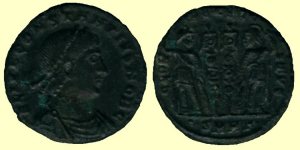
Constantius II 337-361 A.D.
By clicking on the pictures you'll be linked to a more complete description of the coin. At the bottom of this page there is a more elaborate biography of the emperor.
 |
Obverse: FL IVL CONSTANTIVS NOB C |
| Reverse: GLORIA EXERCITVS | |
|
Fieldmarks: -
|
|
| Exergue: |
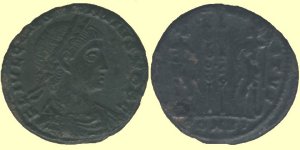 |
Obverse: FL IVL CONSTANTIVS NOB C |
| Reverse: GLORIA EXERCITVS | |
|
Fieldmarks: a
|
|
| Exergue: CONS? |
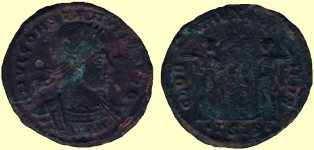 |
Obverse: FL IVL CONSTANTIVS NOB C |
| Reverse: GLORIA EXERCITVS | |
|
Fieldmarks: -
|
|
| Exergue: |
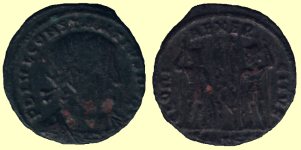 |
Obverse: FL IVL CONSTANTIVS NOB C |
| Reverse: GLORIA EXERCITVS | |
|
Fieldmarks: -
|
|
| Exergue: SMTSΓ |
 |
Obverse: DN CONSTANTIVS PF AVG |
| Reverse: FEL TEMP REPARATIO | |
|
Fieldmarks: -
|
|
| Exergue: SMNΔ |
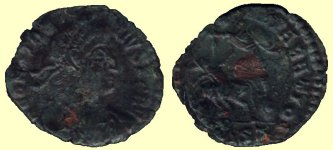 |
Obverse: DN CONSTANTIVS PF AVG |
| Reverse: FEL TEMP REPARATIO | |
|
Fieldmarks: -
|
|
| Exergue: ?SIS |
 |
Obverse: DN CONSTANTIVS PF AVG |
| Reverse: FEL TEMP REPARATIO | |
|
Fieldmarks: -
|
|
| Exergue: ΓSIS |
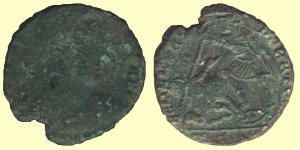 |
Obverse: DN CONSTANTIVS PF AVG |
| Reverse: FEL TEMP REPARATIO | |
|
Fieldmarks: an S in the left field of the reverse
|
|
| Exergue: TES |
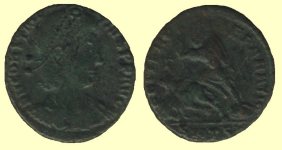 |
Obverse: DN CONSTANTIVS PF AVG |
| Reverse: FEL TEMP REPARATIO | |
|
Fieldmarks: Γ (gamma) in the left field of the reverse
|
|
| Exergue: SMTS |
 |
Obverse: DN CONSTANTIVS PF AVG |
| Reverse: FEL TEMP REPARATIO | |
|
Fieldmarks: a ε in the left field
|
|
| Exergue: SMH? |
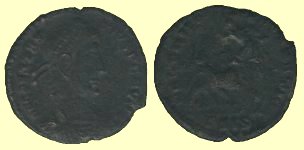 |
Obverse: DN CONSTANTIVS PF AVG |
| Reverse: FEL TEMP REPARATIO | |
|
Fieldmarks: -
|
|
| Exergue: ΓSIS |
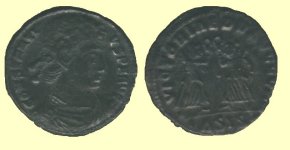 |
Obverse: CONSTANTIVS PF AVG |
| Reverse: VICTORIAE DD AVGG Q NN | |
|
Fieldmarks: -
|
|
| Exergue: |
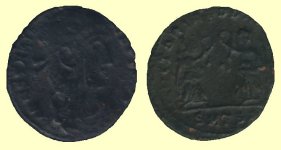 |
Obverse: CONSTANTIVS PF AVG |
| Reverse: VICTORIAE DD AVGG Q NN | |
|
Fieldmarks: a
|
|
| Exergue: SMTSA |
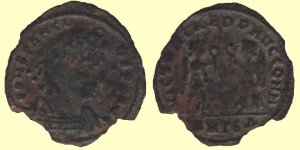 |
Obverse: CONSTANTIVS PF AVG |
| Reverse: VICTORIAE DD AVGG Q NN | |
|
Fieldmarks: -
|
|
| Exergue: SMTSΔ |
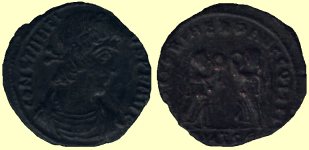 |
Obverse: CONSTANTIVS PF AVG |
| Reverse: VICTORIAE DD AVGG Q NN | |
|
Fieldmarks: a
|
|
| Exergue: SMTSε |
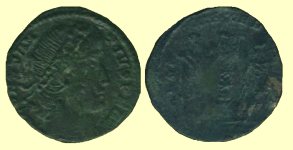 |
Obverse: DN CONSTANTIVS PF AVG |
| Reverse: GLORIA EXERCITVS | |
|
Fieldmarks: -
|
|
| Exergue: - |
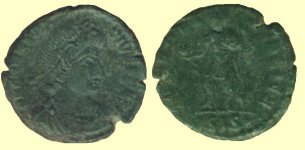 |
Obverse: DN CONSTANTIVS PF AVG |
| Reverse: SPES REIPVBLICE | |
|
Fieldmarks: -
|
|
| Exergue: εSIS |
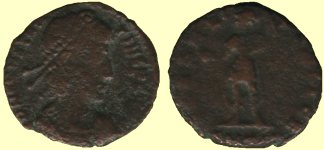 |
Obverse: DN CONSTANTIVS PF AVG |
| Reverse: SPES REIPVBLICE | |
|
Fieldmarks: -
|
|
| Exergue: SMTS? |
Constantius II 337-361 A.D.
Flavius Julius Constantius, second son of Constantine I (The Great) and Fausta, was born on the 7th of August 317 AD in Illyricum. He was given the rank of Caesar in 324 at Nicomedia, after his father defeated Licinius (Constantine I and Licinius were co-rulers of the empire). At the time of his father's Tricennalia (thirtieth anniversary of his acclamation as emperor in 336 AD) he went to Constantinople and married his first wife, the daughter of his uncle Julius Constantius. Constantine the Great died in May 337, and Constantius, who was campaigning in the east, rushed back to Constantinople and arranged for his father's funeral. One of the first things Constantius and his two brothers did was to get together and murder all of their relatives who were considered a threat to the security of their thrones. The only male family members who survived were their cousin Julian and his half-brother Gallus (the sons of their uncle Julius Constantius) they where probably spared because of their young age or perhaps, and more likely, their young age in combination with the fact that they where brother and half brother of the wife of Constantius II.
In the first part of September 337 Constantius II and his two brothers (Constantine II and Constans) met at Pannonia where they were acclaimed Augusti by the army to divide up the empire among themselves. On the division of the empire into three administrative regions Constantius received all the eastern territories from Asia Minor to Cyrenaica. Except Thrace which he acquired 2 years later. Constantine's new realm included Britain, Gaul, and Spain and Constans got Italia, Africa, Illyricum, Macedonia, and Achaea. Fifty years previously, Diocletian attempted to end the system of dynastic rule whereby fathers passed the throne to their sons. Now dynasties and all their associated problems were back and civil war would soon follow. Constantine II ruled for only three years before he became involved in a dispute with his younger brother Constans over Italia. Constantine led an army south to punish his brother but was killed in a fierce mountain battle near the city of Aquileia (click here for more info on Aquileia) in 340 AD, his realm was taken over by Constans.
Constantius spent a great deal of his reign on military campaigns he spend several of his summers campaigning against the ancient and bitter enemies of the empire, the Persians. Although he appears to have been a competent general perhaps "mixed success" might be a safer description of Constantius' military career. He succeeded in stopping every major Persian invasion, as the Battle of Singara in 348, costly to both sides, demonstrates. But compared to his immediate successors, Constantius' struggles with the Persians where not so bad.
The Persians were not the only threat to the empire during his reign. Constantius also fought several campaigns against various barbarian groups. The greatest threat however came from a series of usurpers who arose in various sections of the western portion of the empire. To deal with them Constantius made a quick peace treaty with the Persians in 350 and shifted his base of operations from the east to Mediolanum (Milan). The revolts of Nepotian in 350 and that of Silvanus in 355 were put down very quickly (Nepotian and Silvanus where both killed after 28 days of revolt). The revolts of Magnentius (who lead a rebellion in Gaul and killed Constans) and that of Vetranio formed the basis of a more serious threat to Constantius' rule. Both usurpers raised their standards in revolt in 350 and tried to force the emperor to accept them as CO-rulers Although Vetranio was pressed by Constantius into honorable retirement in the same year, it was only after the costly Battle of Mursa in 351 (supposedly 54000 men where killed) and the victory at Mons Seleuci in 353 that Constantius was able to stop Magnentius, who committed suicide in August of 353. In order to keep the Persians in check while he was dealing with these usurpers, Constantius had appointed his cousin Gallus Caesar in 351 and had sent him east to maintain a Roman presence there. Gallus, however, ruled with an iron fist and even challenged his cousin's authority and was put to death by Constantius at the end of 354.
His first wife, the daughter of Julius
Constantius, must have died in the 340s or early 350s because he married his
second wife Eusebia in 353, she passed away in 360. Largely due to the influence
of Eusebia, Constantius appointed Julian
as his Caesar and dispatched him to Gaul
in 355, while he went east to face the Persians again. Julian was a highly competent
soldier and a popular administrator his military successes between 355 and 360
became too much for Constantius to endure. He attempted to weaken Julian by
asking him to send some of his Gallic troops to him for service in the east.
Julian's troops acclaimed him as Augustus during the beginning of 360 and in
361 Constantius II led an army to deal with Julian but died along the way at
a small town called Mopsucranae
in Cilicia
on the 3rd of November 361 AD. On his deathbed, Constantius II named Julian
as his successor to the throne to avoid a succession crisis cause he had no
children to succeed him. At some point in 361 before his death he had married
his third wife Faustina, who bore him his first child a daughter, Constantia,
posthumously. Constantius had been one of the longest-reigning emperors in Roman
history and in the end he was brought down by disease and one of the two people
he didn't consider a threat to his throne.
For this biography I've used the texts from the following websites:
http://www.imperiumromanum.com/
http://www.roman-emperors.org/
http://www.roman-empire.net/
And from: Gibbon's Decline and fall of the Roman empire.